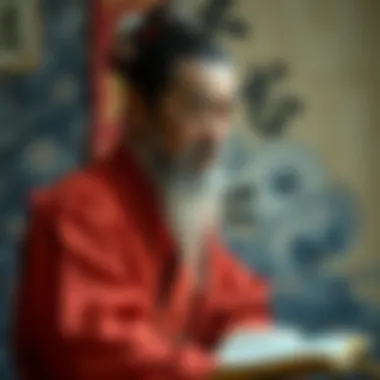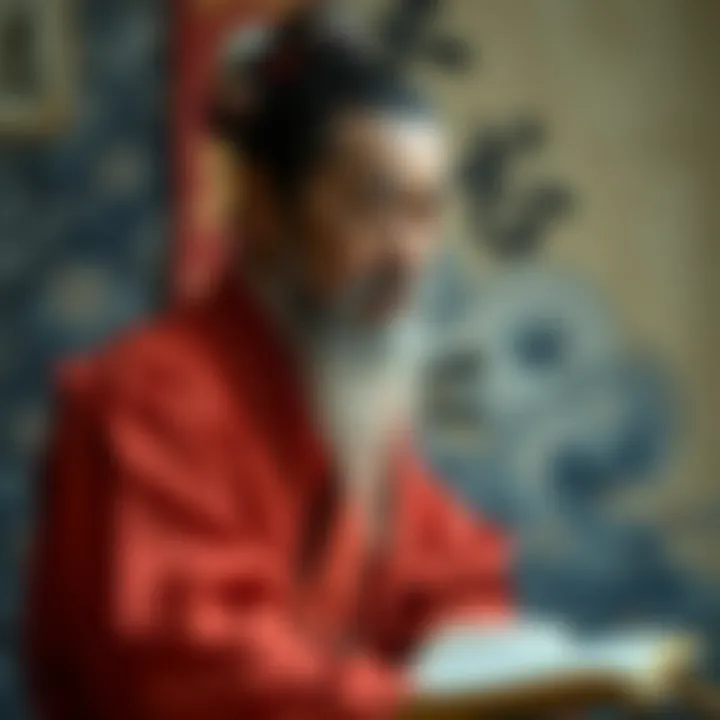Understanding the Depths of Tao Philosophy


Intro
Tao philosophy, with its roots stretching back to ancient China, weaves a rich tapestry of thought that resonates across continents and centuries. At its core, it presents a worldview that invites deep contemplation about the nature of existence and our place within it. Unlike rigid dogmas, Taoism encourages flexibility and adaptability, akin to water flowing around obstacles, suggesting that embracing the natural flow of life is key to harmony.
The central concept of the Tao, which can be translated to mean "the Way," serves as both a guiding principle and a source of ultimate wisdom. This philosophy emphasizes the interconnectedness of all things, advocating for a lifestyle that promotes balance through simplicity. In a world often defined by chaos and complexity, these ancient teachings offer profound insights into achieving personal growth and navigating modern challenges.
As we embark on this exploration of Tao philosophy, we aim to delve into its historical context, the essential tenets such as Wu wei and Yin-Yang, and how these ideas shape ethical and spiritual paradigms today. This journey is not merely an academic pursuit; it's a roadmap for personal development and understanding the intricate dance of life.
Key Lessons from the Book
Lesson Overview
The teachings of Tao philosophy can be likened to hidden pearls waiting to be discovered. Central lessons derived from this wisdom involve understanding one’s inherent nature, the significance of living in harmony with the environment, and the importance of effortless action, or Wu Wei. By letting go of excessive control and expectation, individuals can align more closely with the natural rhythms of life.
- The Nature of the Tao: It is often described as something that cannot be fully grasped or articulated. Instead of being a destination, it encourages a journey of exploration and realization.
- Wu wei (Effortless Action): This concept is about taking action in accordance with the flow of the universe. When we stop forcing things and start allowing, we often find solutions to problems appear with ease.
- Yin-Yang Dynamics: This principle illustrates how opposites are interconnected and interdependent. Recognizing the balance of these forces can lead to a more comprehensive understanding of life’s dualities.
Practical Applications
In today’s fast-paced society, the practical applications of Tao philosophy are invaluable. Here are a few ways to integrate these ancient teachings into daily life:
- Mindfulness Practices: Engaging in meditation or simply spending time in nature helps cultivate presence and awareness, key aspects of aligning with the Tao.
- Sustainability: Embracing Wu wei can lead to more sustainable living choices. Instead of forcing change, one can nurture and grow through conscientious actions that harmonize with nature.
- Conflict Resolution: Applying the insights from Yin and Yang can aid in navigating conflicts by recognizing the duality of perspectives, fostering empathy and understanding.
"The journey of a thousand miles begins with one step." - Laozi
These lessons not only enrich personal understanding but also enhance interactions with others, paving the way for a more harmonious existence.
Author Insights
Author Background
Tao philosophy is often attributed to Laozi, a figure shrouded in mystery and reverence. Some believe he was a contemporary of Confucius, while others assert he lived centuries earlier. His main work, the Tao Te Ching, offers profound insights through poetic aphorisms that challenge readers to rethink their approach to life and leadership. Understanding the context in which Laozi wrote can shed light on the timeless relevance of his ideas.
Key Themes Explored
Within Tao Te Ching and related texts, several key themes emerge:
- Simplicity Over Complexity: Laozi warns against the chaos that often accompanies a convoluted life.
- Natural Order: His teachings stress the importance of aligning with the natural order of things, fostering a sense of peace and fulfillment.
- Transformation and Growth: The Tao encourages a dynamic interplay of change, suggesting that through acceptance, one can find great strength and resilience.
By embracing these themes, one can cultivate a life that mirrors the principles of Tao philosophy, leading to greater clarity and purpose.
For further exploration, you might find resources such as the Tao Te Ching on Wikipedia and scholarly insights on Britannica beneficial in deepening your appreciation and understanding of Taoist thought.
Prolusion to Tao Philosophy
The exploration of Tao philosophy is not only a journey into ancient thought but also a significant avenue for understanding modern life. At its core, Taoism invites individuals to contemplate the essence of existence, encouraging a harmony with nature and the universe. This intro serves as an essential entry point into the deeper layers of Taoist beliefs and practices. Through examining the rich historical foundations and foundational texts, readers will gain insights into how these age-old ideas continue to resonate today.
Historical Background
Taoism, which emerged around the 4th century BCE in China, stems from a context of warring states and philosophical inquiry. The tumult of the time sparked diverse thought, with scholars like Laozi and Zhuangzi influencing the discourse. Laozi, often seen as the father of Taoism, offers foundational insights into the Tao in the "Tao Te Ching." This historical backdrop adds depth, as it situates Tao philosophy within a larger framework of Chinese culture and other philosophies like Confucianism.
An interesting aspect is how Taoism intertwines with natural world's rhythms, advocating for a return to simplicity and spontaneity. Historically, Taoism has adapted over centuries, evolving in response to societal changes while retaining core principles. Such adaptability underscores its relevance in various social issues, making its study worthwhile.
Foundational Texts
When discussing Tao philosophy, two core texts stand out: the "Tao Te Ching" and "Chuang Tzu." These works do not merely convey philosophical ideologies but instead challenge readers to grasp the subtleties of existence and the fluidity of thought.
Tao Te Ching
The "Tao Te Ching" is perhaps the most celebrated work within Taoism, renowned for its poetic, almost cryptic style. It distills complex ideas into succinct aphorisms, offering profound insights on the nature of being and non-being. Its key characteristic lies in its concept of the Tao as a source of all things, advocating for a life in accordance with nature’s rhythms.
This text is essential for this article as it lays the groundwork for understanding Taoist principles. Readers can find beneficial guidance in its teachings, as it champions humility and simplicity. The unique feature of the "Tao Te Ching" is its paradoxical expressions, which can be both illuminating and perplexing, thereby leading to various interpretations, a factor that enriches discussions around it.
Chuang Tzu
The "Chuang Tzu" supplement the ideas presented in the "Tao Te Ching," adding layers of nuance through stories and anecdotes. This text employs humor and surrealism to examine philosophical questions, emphasizing the relativity of perspectives. One of its key characteristics is the focus on personal experience over conformity to rigid doctrines.


This text is particularly interesting for our audience, offering a popular avenue into the whimsical side of Taoist teaching. The unique feature lies in its narrative style, which can be more relatable than the aphoristic stance of the "Tao Te Ching." While some may find its stories too abstract, they undeniably encourage deeper contemplation and reinforce core Taoist values.
Ultimately, these two texts form the backbone of understanding Tao philosophy, allowing readers to engage with profound concepts through different lenses. Through their historical significance and unique narratives, they reveal much about the essence of Taoism and its continued resonance in contemporary discussions.
Core Concepts of Tao Philosophy
Tao philosophy, at its heart, revolves around essential principles that encourage a deeper understanding of life, the universe, and our place within it. Grasping the core concepts of Tao is pivotal as they offer a cradle for both thought and practice, guiding individuals towards a more harmonious existence. The beauty of this philosophy lies in its simplicity and profound nature, inviting exploration into aspects such as the Tao itself, the principle of Wu wei, and the dynamics of Yin and Yang. Each of these elements interlocks, creating a tapestry that informs practitioners about balance, natural flow, and ultimate interconnectedness.
The Tao
Definition of the Tao
The concept of the Tao is fundamental to Tao philosophy. It is often described as the ultimate source of everything; a force that is both formless and form, embodying both simplicity and complexity. This dual nature makes it a captivating aspect, as it challenges our conventional ways of thinking about existence.
One key characteristic of the Tao is that it is seen as an ongoing process rather than a static state. It’s like a river flowing freely; never the same at any given moment. This essence fosters a beneficial connection between the individual and the universe, serving as a reminder that change is a constant that should be embraced rather than feared. The Tao’s unique feature is that it provides a philosophical framework that encourages individuals to tune into the rhythm of nature and their own inner voice, allowing for a more authentic way of living.
The Tao as the Source of All Things
Describing the Tao as the source of all things offers profound implications. This perspective emphasizes that all existence originates from this singular, universal principle. It suggests that every event, interaction, and being is inherently connected to the Tao, leading to an understanding of the intricate web of life.
The key characteristic here is that the Tao is non-discriminative; it does not favor one entity or phenomenon over another. This inclusiveness makes it a useful choice for those seeking personal growth and clarity. The unique feature of considering the Tao as the source is that it resonates with individuals striving for harmony, as it promotes respect and moderation. However, one disadvantage is that such abstract ideas can sometimes feel intangible, making it challenging for individuals to integrate them into daily life.
Wu wei
Understanding Non-Action
Wu wei translates to “non-action” or “effortless action.” This principle underscores the idea of aligning with the natural flow of events rather than forcing outcomes. Understanding this concept is essential as it redirects focus from relentless striving to embracing simplicity and spontaneity.
The core characteristic of wu wei is its paradoxical nature; it offers power through yielding. This approach is particularly beneficial as it encourages practitioners to respond to situations rather than react impulsively. Embracing wu wei can lead to enhanced clarity in decision-making, as there is less emotional clutter. The unique aspect here is its practical application in daily life, promoting actions that feel intuitively right rather than merely tactical. However, difficulty may arise in a fast-paced world where action is often equated with productivity.
Practical Implications of Wu wei
The practical implications of wu wei extend beyond philosophical abstraction into real-world applications. This principle can influence areas ranging from conflict resolution to creative processes, urging individuals to find paths that require the least resistance.
What’s beneficial here is that wu wei teaches the value of patience, reminding individuals that sometimes stepping back can result in greater outcomes than forceful approaches. The unique application of this principle is seen in practices like meditation, where letting thoughts come and go unobstructively can bring clarity. Yet, in our goal-oriented society, reliance on non-action might be misinterpreted as passivity, which can deter some from fully embracing it.
Yin and Yang
Interconnectedness of Opposites
Yin and Yang symbolize the duality inherent in existence; they illustrate how seemingly opposing forces are interconnected and interdependent in the natural world. The principle of interconnectedness is vital to grasping the complexity of life and balance.
A key characteristic of this concept is that neither force is superior; both are essential. This understanding is beneficial, as it invites acceptance of contradictions and complexities within ourselves and our relationships. The uniqueness of Yin and Yang is that they exemplify the fluidity of life, constantly transforming into one another. However, a misunderstanding of this coexistence can lead to oversimplification of issues, neglecting the nuances that accompany human emotions and experiences.
Balance in Life
The idea of balance is crucial within Taoism, encapsulated beautifully in the dynamic interplay of Yin and Yang. Striving for balance can guide individuals towards leading a more fulfilled life by recognizing and honoring all facets of their being.
One key aspect of balance is that it is not static; it is a continual adjustment, much like a dancer shifting in response to the music’s rhythm. This adaptability is beneficial as it fosters resilience against life’s uncertainties. The unique feature of seeking balance in life is that it incorporates various dimensions—physical, emotional, and spiritual—creating a holistic approach to well-being. But the downside lies in the misconception that balance must be achieved perfectly, causing unnecessary stress.
The essence of Tao philosophy lies in its profound simplicity and rich complexity, inviting each person to walk their own path while remaining connected to the flow of the universe.
In summary, the core concepts of Tao philosophy offer essential insights that pave the way for a deeper understanding and appreciation of life. Whether through embracing the essence of the Tao, embodying wu wei, or finding balance through Yin and Yang, these principles reveal a pathway to greater harmony and fulfillment.
Philosophical Dimensions
In exploring Tao philosophy, one cannot overlook the rich tapestry woven through its philosophical dimensions. This section aims to unpack how these aspects play a vital role in understanding the very essence of Taoism and how they inform both personal perspectives and societal norms.
Metaphysics of Taoism
Taoism offers an intriguing metaphysical framework that distinguishes its philosophical stance. At its core, the metaphysics of Taoism posits that the universe is a living, dynamic entity influenced by the Tao, which is often translated as "the Way." This foundational idea presents the universe not as a mere machine, but as an interconnected web where everything is in a continual state of transformation.
The way we perceive reality within this context becomes crucial. Simply put, reality is not static; it’s fluid and exists in constant flux. This perspective urges individuals to embrace adaptability and flow with life’s currents. Understanding this aspect is not just an academic exercise but a practical tool for navigating the complexities of life. By accepting the inherent change in life, one cultivates resilience, which is vital in today’s fast-paced world.
Ethics in Tao Philosophy
Delving deeper into Taoism reveals profound ethical considerations that can significantly influence behavior and decision-making.


Naturalness and Simplicity
Naturalness and simplicity are fundamental principles in Tao philosophy that advocate for an authentic life. To be natural is to act in a way that is true to oneself, free from the artifice too often imposed by societal expectations. This principle becomes a guidepost for individual conduct, urging people to strip away complexities and live simply.
The key characteristic of naturalness lies in its emphasis on spontaneity. Rather than forcing actions or conforming to external pressures, it encourages aligning oneself with personal truth and the natural world. This approach is beneficial as it nurtures mental ease and clarity. Recapturing a sense of simplicity helps reduce life's overwhelm, creating space for serenity and genuine connections with others.
A unique feature here is how simplicity does not equate to superficiality; rather, it recognizes inner richness. This is an inviting choice for those keen on enhancing their quality of life, offering both advantages such as reduced stress and disadvantages like societal pushback against such a radical change.
Compassion and Harmony
The ethos of compassion and harmony in Tao philosophy forms another cornerstone of ethical practice. It emphasizes the importance of caring for others and fostering unity within communities. Compassion serves as a bridge connecting individuals to one another. This aspect encourages a compassionate response to the challenges faced in a world filled with disparity.
Key characteristics of compassion in this light include its action-oriented nature; it's not just a feeling but manifesting in behaviors of kindness. Such an outlook can significantly enhance social cohesiveness, making it a compelling choice for readers who seek a deeper connection with their communities.
Moreover, the concept of harmony embodies the idea that the universe thrives on balance. Recognizing and respecting different perspectives allows for the coexistence of various truths, enriching the collective experience. However, the challenge lies in balancing this compassion within a personal context, ensuring that it does not lead to self-neglect.
In Tao philosophy, to touch the hearts of others, we must first cultivate compassion within ourselves.
In summary, the philosophical dimensions of Taoism serve as a rich wellspring of guidance for ethical living. By weaving these teachings into daily life, one can create a more meaningful existence, harmonized with the flow of the universe.
Spiritual Aspects of Tao Philosophy
The spiritual dimensions of Tao philosophy offer profound insights into achieving inner peace and harmony with the universe. This aspect is vital in understanding Taoism's application in our daily lives, as it serves as a bridge connecting ancient teachings with modern spirituality. By diving into meditation and rituals, we can see how these practices align with the core Taoist principles, providing pathways for personal growth and tranquility.
Meditation and Mindfulness
Meditation and mindfulness in Tao philosophy are not merely about emptying one's mind, they serve as tools to cultivate awareness and serenity. Taoist meditation encourages practitioners to tune into the rhythm of nature and the universe. This intimate connection with the environment forms the foundation of a meditative practice rooted in the concept of the Tao itself.
Practicing meditation can lead to numerous benefits, including reduced stress, enhanced clarity of thought, and a deeper sense of connection with the surrounding world. Many Taoist meditative techniques emphasize the cultivation of inner stillness and observation, allowing individuals to harmonize their thoughts and emotions. This process is about acknowledging and releasing distractions rather than striving for unattainable ideals. The recognition that all things are interconnected leads to a more profound sense of belonging and purpose.
Rituals and Practices
Rituals and practices in Taoism play a significant role in embodying the teachings of the philosophy. These activities not only reinforce beliefs but also serve to bring communities together. Practicing rituals can enhance one's understanding of life's cycles and the intricacies of existence.
Taoist Rituals
Taoist rituals are steeped in tradition and aim to align participants with the Tao. Typically, these rituals involve offerings, chanting, and guided meditations. One key characteristic is their adaptability; these rituals can be performed both individually and collectively. This flexibility makes them a popular choice among practitioners as they cater to different settings and personal preferences.
A unique feature of these rituals is their emphasis on intention. When participants engage sincerely, the rituals aim to facilitate a connection with the natural world and transcend ordinary experiences. Through the focus on altruism and community spirit, Taoist rituals can foster a sense of unity among participants, allowing for a shared emotional experience. However, some might argue that without a deep understanding of the underlying philosophical concepts, the rituals might feel superficial to outsiders.
Practicing the Way
Practicing the Way in Taoism involves integrating the key principles of Tao philosophy into everyday life. This aspect goes beyond rituals, focusing on how individuals walk their path in the world. Central to this practice is a commitment to naturalness and simplicity, reflecting the idea that life flows best when one is in harmony with the Tao.
A defining characteristic of Practicing the Way is the idea of living with intention and mindfulness. It's about making conscious choices that align with one’s values, which can be particularly beneficial in today's fast-paced environment. A unique trait of this practice is that it invites individuals to reflect on their actions, fostering personal growth and self-awareness. However, this path requires discipline and patience, which can sometimes be challenging in a world full of distractions.
In essence, the spiritual aspects of Tao philosophy encourage us to cultivate a life reflective of our true nature, unearthing a deeper understanding of ourselves and the world around us. These practices provide vital tools for individuals seeking to navigate life's complexities with grace and balance.
"The journey of a thousand miles begins with a single step."
Taoism invites us to explore our inner landscapes while grounded in shared experiences, enriching both personal and communal connections. Integrating these spiritual aspects into daily life can lead to a more harmonious existence, knowledgeable and content in the present moment.
For a more detailed understanding of Taoism, consider exploring resources such as Encyclopedia Britannica and Wikipedia.
Tao Philosophy in Modern Context
In today’s fast-paced world, the timeless wisdom of Tao philosophy holds great significance. Adapting ancient insights can offer a fresh perspective on modern challenges. As more individuals seek balance and clarity amidst chaos, the relevance of Taoism shines a light on navigating life with grace and understanding.
Relevance in Contemporary Society
Tao philosophy emphasizes harmony with the natural flow of existence. This principle resonates deeply in contemporary society where chaos and overstimulation become the norm. The idea of going with the flow can alleviate feelings of overwhelm.
- Simplicity is perhaps the most appealing aspect of Taoism in today's context. Simplicity does not suggest minimalism in a material sense, but rather, an uncluttered mindset. By stripping away the unnecessary, individuals can focus more on what truly matters, like relationships and self-reflection.
- Mindfulness, a practice rooted in ancient traditions, finds its place in the hustle and bustle of urban life. Taoist practices encourage being present, which many find essential in a world rife with distractions.
"Living in accordance with the Tao enables one to experience life's ebb and flow, leading to inner peace and resilience."


Influence on Psychology and Well-being
In recent years, there's been growing interest in how Tao philosophy intersects with psychology and well-being. The therapeutic community increasingly recognizes the benefits of integrating these ancient teachings into modern psychological practices.
Integration with Psychotherapy
Tao philosophy offers a unique lens through which therapists can engage with clients. It brings a sense of naturalness to the therapeutic process. The core concept of wu wei, or non-action, encourages clients to find their own path without forcing change.
- This aspect fosters an atmosphere of acceptance, making therapy feel less like a chore and more like a journey. Therapists who integrate this approach often find their clients are more open and engaged.
- A key advantage of this integration is that it minimizes the pressure clients may feel to conform to strict therapeutic milestones. Instead, they can navigate their personal growth at their own pace, guided by their unique experiences and insights.
Impact on Stress Reduction
Research suggests that the principles of Tao philosophy can significantly mitigate stress. In a world plagued by anxiety, the emphasis on harmony can be a game-changer.
- Techniques drawn from Taoism, such as deep breathing and meditation, can easily blend into daily routines. These practices focus on the present moment, promoting a sense of peace and reducing stress levels.
- Moreover, applying the concept of yin and yang helps in recognizing the interplay of stress and relaxation in one’s life, encouraging a balanced approach to dealing with stressors.
Incorporating these ideas into daily life doesn’t have to be a monumental task. Small adjustments, like practicing mindfulness during mundane activities, can lead to substantial improvements in mental health.
The threads connecting Tao philosophy, psychology, and modern well-being are becoming ever more apparent. Understanding this relationship not only enriches personal practice but also stands as a testament to the world’s enduring need for ancient wisdom in navigating contemporary life.
Taoism and Art
Taoism offers a unique lens through which to view the interplay between art and philosophy. It’s not merely about aesthetics but rather an invitation to engage with nature and the essence of existence. The principles of Taoism manifest beautifully in various artistic expressions, from paintings to literature.
In examining Taoism and art, we seek to uncover specific elements that highlight the deep connection between the two. Art, under the influence of Taoist thought, often emphasizes simplicity, naturalness, and the balance between opposites. This alignment allows artists to create works that resonate not just visually but deeply with the human experience. It can encourage a mindfulness in creation, reflecting a way of being that is harmonious with the rhythms of the universe.
Benefits of Artistic Expression in Taoism
- Connection to Nature: Taoist art frequently reflects the beauty of the natural world, serving as a reminder of humanity’s connection to nature.
- Promotion of Inner Peace: Engaging with art can foster a sense of tranquility and encourage deeper reflection on one’s life.
- Cultural Transmission: Through various forms, Taoist art keeps the philosophy alive, passing down teachings to future generations.
These considerations do not just illustrate the significance of Taoism in creative fields but also reveal how much art can contribute to understanding and practicing Taoist principles in everyday life.
Representation in Visual Arts
In visual arts, Taoism finds expression through tranquility and natural landscapes. Artists like Fan Kuan, who painted "Travelers Among Mountains and Streams," convey a sense of connection to the universe. Here, the mountains are not just backdrops but characters interacting with humanity's small presence within an expansive cosmos.
The use of ink wash in Chinese landscape paintings exemplifies this relationship. The fluidity of the brush strokes cultivates a feeling of spontaneity and alignment with the Tao's flow. This practice illustrates the Taoist belief that art should reflect the natural rhythm of life and the ebb and flow of existence.
Influence on Literature
Literature influenced by Taoist philosophy often reflects its core tenets, encouraging readers to find beauty in simplicity and authenticity. Works inspired by Taoism offer profound insights into the human condition, emphasizing the interconnectedness of all things.
Philosophical Themes in Poetry
One specific aspect of philosophical themes in poetry relates to the exploration of nature's inherent wisdom. Taoist poets, such as Laozi and Zhuangzi, use imagery from the world to illustrate complex ideas, seeking to convey messages indirectly. The key characteristic of this thought-provoking style is its focus on simplicity and clarity, making it accessible yet rich with meaning. This simplicity enhances the reader’s journey, allowing for personal reflection and interpretation.
The unique feature of Taoist poetry lies in its ability to convey existential concepts without overwhelming the senses. The advantage of this approach is its capability to invite contemplation, enabling readers to ponder their place within the grand mosaic of existence.
Narrative Structures in Taoist Literature
The narrative structures often employed in Taoist literature contribute significantly to its storytelling style. Characters often embark on journeys that reflect the philosophical underpinnings of Taoism, reinforcing ideas like spontaneity and being present in the moment. The key characteristic of such narratives is their non-linear progression. Instead of a typical beginning, middle, and end, these stories emphasize episodes filled with parables and lessons.
This method proves beneficial as it mirrors the way life unfolds, encouraging readers to embrace uncertainty and unpredictability. The unique feature of these narratives revolves around the use of anecdotes and fables that not only entertain but also impart wisdom. This interplay between storytelling and ideology serves as an effective tool for cultural transmission and philosophical exploration.
Culmination
In wrapping up our exploration of Tao philosophy, it’s crucial to emphasize the significance of both the insights derived from its tenets and the potential they hold for influencing lives today. This philosophy encourages a way of living that emphasizes harmony, balance, and simplicity, but more than that, it’s a philosophy calling for a deeper relationship with the self and the environment.
Summary of Key Insights
Tao philosophy hinges on several profound insights that resonate beyond the confines of ancient texts. First and foremost is the concept of the Tao itself—an idea that represents the ultimate source of all existence. Understanding this not only facilitates a comprehension of the universe but also encourages mindfulness in everyday living. Wu wei, or the principle of non-action, is another vital aspect, reminding us that sometimes doing less can result in greater accomplishments and peace of mind. Yin and Yang illustrate the interconnectedness of opposites, teaching us that balance is inherent in nature and vital in our lives.
The ethical dimensions of Tao philosophy promote naturalness and simplicity, which are increasingly relevant as our fast-paced world often pulls us in directions that cause stress and discontent. Compassion, as highlighted in this philosophy, underscores the importance of relations with others, fostering harmony in communities. Moreover, the integration of Taoism in modern contexts—be it through psychology, art, or everyday practices—continues to echo its timeless relevance.
Tao Philosophy's Future Trajectory
Looking ahead, the future of Tao philosophy appears promising, as more individuals seek alternatives to the often chaotic lifestyles shaped by contemporary demands. As enthusiasts pursue a deeper understanding and application of these ancient principles, they may find that Taoism offers guidance in navigating complex personal and societal challenges.
Educational institutions and wellness programs are increasingly incorporating concepts from Tao philosophy into curricula, promoting mindfulness practices and holistic health approaches. The philosophy’s adaptability suggests it will continue to inspire new perspectives and movements that align with nature’s flow.
Furthermore, the rise of digital platforms enables a broader audience to engage with Taoist principles. Online communities, articles, and forums enrich discussions about its implications in today’s world. In challenging times marked by uncertainty, the fundamental ideas in Tao philosophy—emphasizing connection, peace, and balance—ring more relevant than ever.
In summary, the journey through the realms of Tao philosophy, from ancient texts to modern applications, reveals a rich tapestry of insights that can enhance personal growth and understanding of the world. As we forge into the future, these teachings will undoubtedly continue to illuminate paths for those willing to explore their depths.



